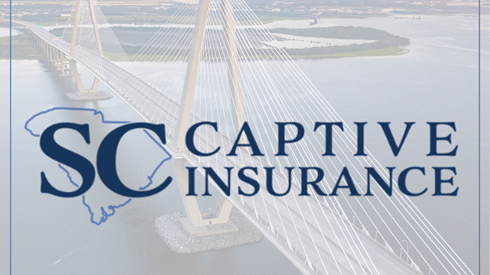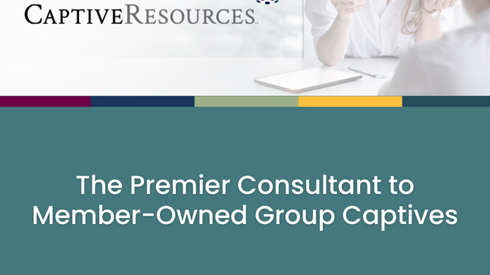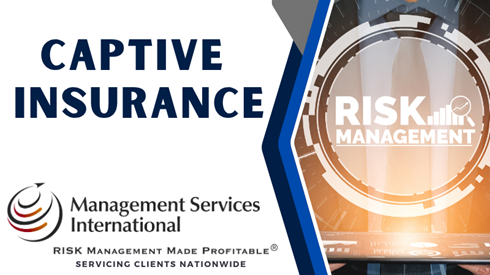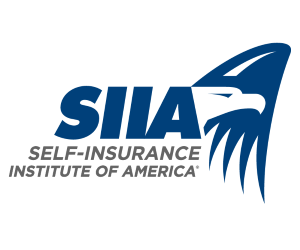Captive Insurance in 2025: Growth, Challenges, and Opportunities

January 03, 2025

The growth of captive insurance is projected to accelerate further in 2025, driven by companies' needs to address increasingly complex risk management challenges and adapt to emerging risks. Industry experts predict a continued expansion in the applications of captives, reflecting their versatility in managing diverse exposures.
A heightened focus on regulation and compliance is also anticipated, alongside new opportunities for captives to engage with environmental, social, and governance (ESG) initiatives. Furthermore, artificial intelligence (AI) is expected to play an increasingly transformative role in the captive landscape, enhancing data analysis, supporting strategic decision-making, and improving operational efficiency.
Michael Maglaras, principal of Michael Maglaras & Company, emphasized the growing importance of captive insurance in addressing global challenges, stating, "I'm predicting greatly increased uses of captive insurance companies and structures to augment worldwide catastrophic coverage capacity in two areas: the potential for another worldwide pandemic and the effects of climate change on the availability of property and related time-element coverages. Increasingly, captive programs, including those sponsored by governments, will play a robust role in assuring coverage availability in these two areas alongside the commercial marketplace."
Steve Bauman, head of global programs and captive practice North America at AXA XL, shared his enthusiasm for the expanding role of captives, stating, "For 2025 and beyond, the increased maturity and strengthening of captive insurance companies opens increased opportunities for captives to play bigger and broader roles in risk management. I can't help but be excited about the partnerships that will be needed in corporate risk management to support the future growth of [AI] and autonomous mobility.
"The future of captives is exciting, not only for large corporations but also for many smaller companies that can pursue the captive experience via group and cell captives and embrace risk management resiliency."
Anne Marie Towle, CEO of Global Risk and Captive Solutions at Hylant Global Captive Solutions, added, "The outlook for 2025 suggests continued innovation and strategic growth in the captive insurance space, with the potential softening of the commercial insurance market creating new opportunities. Captive strategies are expected to focus on voluntary benefits, supply chain risk financing, and the ever-relevant challenges of cyber security.
"Emerging trends, including the use of [AI] in underwriting and claims, present both opportunities and uncertainties for the industry. Captive professionals will benefit from collaboration and expertise sharing through conferences and professional networks, ensuring captives remain well-positioned to adapt to market changes and support broader organizational goals."
Property Risk Opportunities
Given the ongoing challenges in placing property risk in the commercial market, Joe Rosenberger, chief captive analyst at the North Carolina Department of Insurance's captive insurance companies division, anticipates the continued trend of business owners using captives to secure coverage in 2025. He also predicts the growing popularity of deductible reimbursement and warranty reimbursement policies will persist into the new year.
Jarid Beck, a managing director at Risk Management Advisors, agreed, stating, "As we look ahead to 2025, the property insurance market is expected to show increased responsiveness to innovative risk management strategies. Following a challenging period marked by limited flexibility in pricing adjustments, the market appears to be shifting toward a more dynamic approach that rewards businesses willing to explore tailored risk solutions.
"If that fully materializes, captive insurance will play a key role in the evolution, helping companies to retain sizable yet manageable risks while accessing reinsurance markets for broader protection. This shift not only enhances cost efficiency but also aligns with the growing demand for customized, client-focused solutions."
Employee Benefits: A Key Growth Area
Another key growth area, according to Prabal Lakhanpal, senior vice president at Spring Consulting Group, will be the formation of group captives for employee benefits, including medical stop-loss and other lines of coverage such as voluntary benefits.
"Employers are seeing healthcare costs continue to climb and are aggressively seeking solutions to curb the steep increases," Mr. Lakhanpal said. "An ancillary impact of rising healthcare costs has been that employers have had to push higher deductibles and copays onto employees, who, in turn, are exploring voluntary benefits offerings—such as critical illness and accident cover—as potential avenues to limit the financial impact.
"The challenge with commercial market voluntary offerings is that the loss ratios for these coverages are low, and employers want to find a better, more efficient way for their employees to access this coverage. This is why I see medical stop-loss and voluntary benefits becoming front and center for employers in the coming year."
Nick Hentges, CEO of Captive Resources, added, "Even with the head-start that casualty has, I can see medical stop-loss being as large as casualty—that's how much opportunity there is in the space. We are making a big bet on medical stop-loss and believe that we can make a big impact in that area."
Tax and Regulatory Reform: 2025 Outlook
With tax reform as one of the incoming federal government's top priorities, the captive industry anticipates that the Internal Revenue Service (IRS) will issue final regulations for 831(b) captives in the second quarter, according to Ellen Sue Bernards, a board member of the Missouri Captive Insurance Association.
"Following the formal regulations, we anticipate that captive owners, as well as advisers, will have better insight into utilization strategies moving forward," Ms. Bernards said. "With the anticipated uptick in corporate [mergers and acquisitions] transactions under the new administration, the demand for transaction liability insurance will likely grow as well. For captive owners willing to take on the risk, we could see more captives providing capacity for transaction liability insurance."
In addition, Wesley Sierk III, managing director at Risk Management Advisors, noted that as the captive landscape continues to evolve, additional regulatory changes are inevitable. Anticipating these changes and addressing potential compliance issues will be essential for staying competitive, he said.
"Key trends expected include stricter compliance standards—regulators worldwide will increase scrutiny on captive insurance operations," said Mr. Sierk III. "Captives must ensure financial solvency and adhere to all regulatory requirements.
"Next are transparency requirements—captives will face pressure to enhance transparency in financial operations and risk exposures. This may involve detailed reporting and stricter disclosure norms.
"Finally, there is international coordination. With a more interconnected global landscape, regulators are likely to collaborate across jurisdictions, potentially resulting in standardized regulations for captives operating in multiple countries."
ESG and Sustainability Initiatives
With ESG increasingly coming under the spotlight, Jeremy Colombik, managing partner of Management Services International, noted that this shift creates opportunities for captives to address these issues. By leveraging a captive, he explained, companies can better align their risk management strategies with their business principles.
"Captives can be structured to help businesses better manage risks related to their environmental liabilities, such as climate change-related disasters, or to cover risks tied to their social and governance issues, such as human rights violations or corporate governance failures," said Mr. Colombik. "We are seeing a growing demand for sustainability and accountability, which could lead businesses to adopt captives that reflect their commitment to [ESG] practices while mitigating these emerging risks."
State Growth: Vermont and South Carolina's Captive Leadership
After significant growth in 2024, both in the number of captives and premiums written, Ryan Basnett, audits director at the South Carolina Department of Insurance, expects this trend to continue in 2025 as more companies turn to captives over the traditional market. However, he will also be closely monitoring the increasing severity of natural disasters and their impact on the market, as well as rising losses in the commercial auto sector, both of which are already significantly affecting the industry. Additionally, he will be tracking the evolving role of AI.
"There are numerous benefits, including improved risk evaluation, claims analytics, and operational efficiency, but it is important to consider the potential risks associated with AI, such as data security," said Mr. Basnett. "How companies strike that balance will be crucial moving forward. In 2024, South Carolina saw its first captive primarily utilizing AI in its underwriting function, and we expect this trend to continue into 2025."
Sandy Bigglestone, acting commissioner of the Department of Financial Regulation, stated that Vermont will continue to compete on quality and the value it offers to captives choosing to domicile their business in the state as we move into 2025.
"Vermont is seeing an increase in interest from new captive management firms and other service providers," Ms. Bigglestone said. "We welcome the participation of new talent in Vermont's center of excellence and look forward to seeing the outcomes of this growing interest in service provider expansions here."
She added, "All indications suggest that interest in captive formations shows no signs of slowing down despite the impending challenges of a chaotic commercial marketplace."
Moving forward, Mike Meehan, principal at Milliman, anticipates further growth in the captive market in 2025. He said, "It seems reasonable to expect continued growth in the captive market in 2025, as the commercial market remains challenging, particularly within the liability lines of coverage. As the market expands, the demand for industry talent to support that growth will remain a challenge for many organizations.
"I also anticipate more captives being used to address challenges stemming from climate change and the expanded use of parametric insurance. Additionally, the IRS is expected to issue guidance regarding captives making the 831(b) election, which could have a material impact on that specific sector of the industry. Finally, it is unclear at this point what impact, if any, the fall election results and resulting leadership changes will have on the captive industry."
George Belokas, chairperson of the Self-Insurance Institute of America's captive insurance committee and president of GPW and Associates, concluded, "The world is moving quickly, and businesses are discovering risks they didn't even know existed. As customer needs and risks evolve, it becomes increasingly difficult for admitted insurers in the traditional insurance marketplace to respond swiftly to this ever-changing environment. As a result, we will likely continue to see greater use of captives."
Captive Industry Leadership Outlook
Captive Insurance Companies Association President Dan Towle added, "Captive industry growth will remain strong through 2025, even with a softening insurance market among some lines of coverage. Companies utilizing captives are seeing the long-term benefits in both hard and soft markets and will not be leaving the market anytime soon. The expansion of existing captives and new captive formations will fuel significant premium volume growth.
"This will be the year the United Kingdom decides whether it will become part of the captive insurance industry, or it could be a year that goes down in history as a stumble for London as a global insurance leader. If the [United Kingdom] becomes a captive insurance domicile, this could potentially mark a new era in captive development for Europe and perhaps be the most significant news of 2025.
"Retaining key personnel will continue to be a significant issue in 2025. This challenge will persist alongside the sustained growth we are witnessing throughout the industry. We are also continuing to see interest from private equity firms making investments in captive management and other areas of the captive insurance industry.
"This is providing much-needed capital for organizations to grow and offer higher-than-average wages to attract key professionals from other companies. With this increased wage pressure and higher demand for qualified individuals, I expect to see more people moving from company to company."
January 03, 2025











